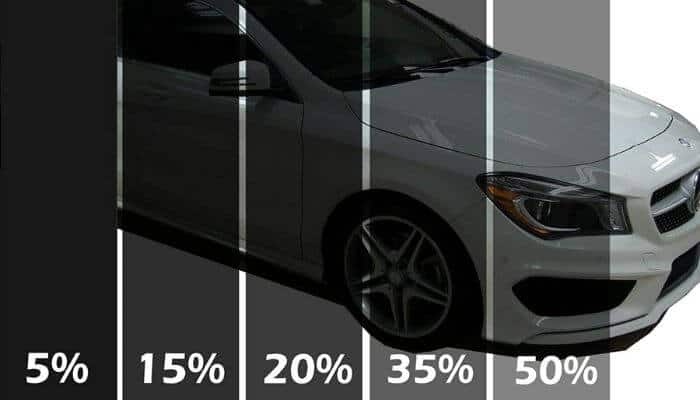When you are driving, the sun is not always on your side. It can make the driver and other people in the car hard to see. Best Car Window Tints. Its UV radiation will slowly break down the things inside, and it can also speed up the aging process and cause skin cancer. And it can make your car heat up like a greenhouse, sometimes more than your air conditioner can handle.
Tinting your car’s windows, on the other hand, makes all of those problems less of a problem and gives you more privacy when you’re on the road. The window tint film is cheap and easy to put on yourself if you have a little patience and pay attention to detail. You can buy kits that are already cut to fit certain vehicles, which cuts down on the time it takes to install and the learning curve.
Or, you can buy the film on a roll, which is cheaper and gives you more room to make mistakes if you do something wrong. Longer rolls even let you do multiple vehicles. There are many tint colors and materials to choose from, so you can get the look and atmosphere you want (see FAQs). But before you buy, check the laws in your state to make sure you get what you need. ceramic tint.
Best Car Window Tints
1. MotoShield Pro Premium Precut Ceramic tint Kit
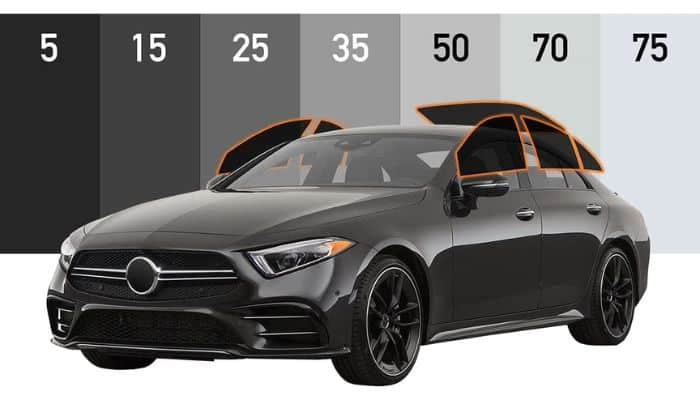
This precut kit of MotoShield Pro’s ceramic film gives you a durable, high-quality window tint that is easier to put on than roll film. Ceramic nanoparticles in this strong 2-mil film block up to 99 percent of UV and infrared radiation. This helps protect the building’s occupants and interior as well as keep more solar heat out. It comes in a wide range of colors, from 5 percent to 75 percent VLT (visible light transmission). You can buy cars, SUVs, minivans, and trucks in a wide range of styles. About $50 buys a 10-foot roll of 20-inch film. 10 window tint and ceramic tint.
| PROS | CONS |
| Ceramic film blocks more infrared radiation and heat than other types, and it holds up better | More expensive than dyed and carbon window tints |
| Precut kits are easier to install than roll film | Three-year warranty is less than some other brands |
| Available in a wide range of tint shades and configurations | Instructions recommend using a heat gun to apply the film |
2. MotoShield Pro Premium Ceramic tint
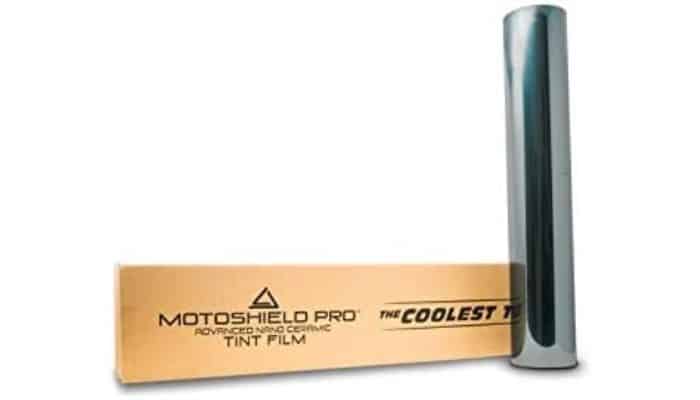
If you’d rather cut your own window tint, you can buy MotoShield Pro’s premium ceramic film in different sizes and at different prices. The price above is for a 10-foot roll of 20-inch film, but you can also get it in other lengths and widths. Or, if you want to do more than one car, you can buy a 100-foot roll of 20-, 40-, or 60-inch film from a professional store. Like the precut kits, this strong 2-mil film comes in a range of colors from 15 to 75 VLT. And its ceramic nanoparticles help block up to 99 percent of UV and infrared radiation. 10 window tint and 70 percent window tint.
| PROS | CONS |
| Ceramic film blocks more infrared radiation and heat than other types, and it holds up better | Roll films require you cut them to fit |
| Rolls of tint film are less expensive overall than precut kits | Three-year warranty is less than some other brands |
| Available in a wide range of tint shades and dimensions | Instructions recommend using a heat gun to apply the film |
3. Lexen Max 2Ply Carbon tint
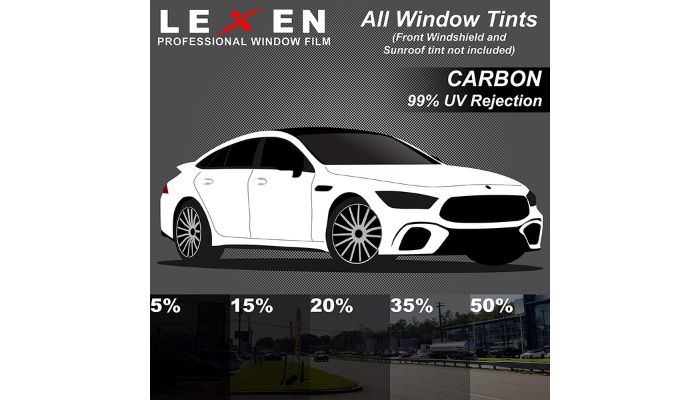
This window tint is a great balance between quality and price because it has tiny carbon particles in it. And since the kit is already cut, it’s easier to put together. This carbon film blocks up to 99 percent of UV rays and more infrared radiation and heat than cheaper dyed films. And it holds up better over time. This 1.5-mil, two-ply film comes in many different colors and has a lifetime warranty. Some users have said that the film can be cut too big and have the shape of the window drawn on it, so you may have to do the final cutting. 10 window tint and 70 percent window tint.
| PROS | CONS |
| Precut kits are easier to install than roll film | More expensive than dyed window tints |
| Less expensive than ceramic films | Carbon film doesn’t block as much heat as ceramic film |
| Carbon films block heat better and hold up better than lower-cost dyed films | You may need to use a heat gun to get it to fit right on some curved windows (such as a rear window) |
4. Lexen Max 2Ply Premium Carbon tint
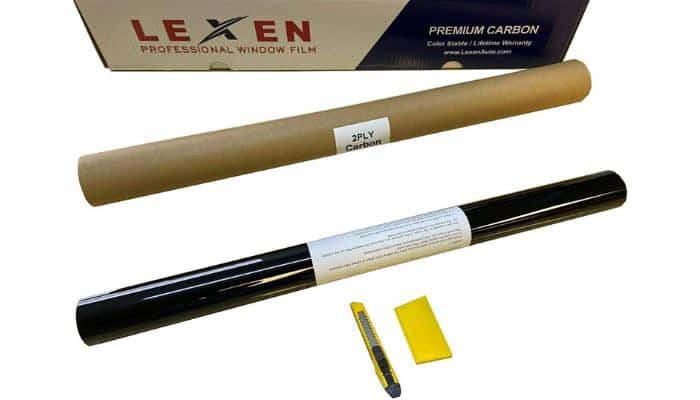
As with the precut kits, Lexen’s strong two-ply, 1.5-mil Premium Carbon film is a great deal that combines quality and affordability. This film reflects more heat and infrared light than dyed films because it has tiny carbon particles embedded in it. It also lasts longer. It also doesn’t make the kind of electronic noise that metallic films do. This price is for a roll that is 24 inches wide and 10 feet long. But you can get it in different widths and lengths, like 100-foot rolls. Warranty for life. 10 window tint and 70 percent window tint.
| PROS | CONS |
| Less expensive than ceramic films | Roll films require cutting them to fit yourself |
| Carbon films block heat better and hold up better than lower-cost dyed films | Carbon film doesn’t block as much heat as ceramic film |
| Available in a range of tint shades | Some users have complained about getting a different tint than they ordered |
5. Gila Heat Shield Basic
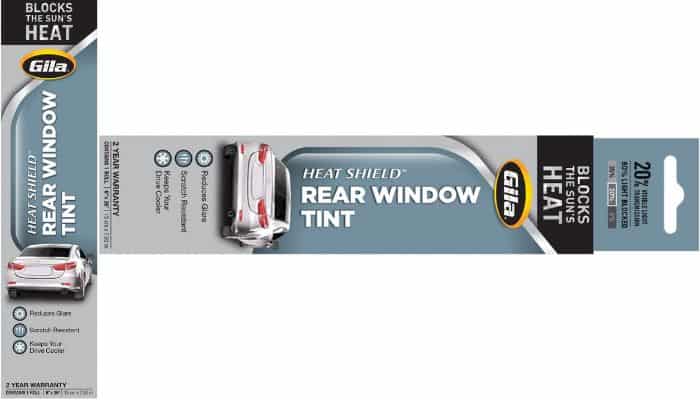
This single-layer, dyed film is one of the cheapest window tints we’ve seen from a reputable company. Eastman Performance Films, which also makes the popular professional brand LLumar, is the parent company of the Gila brand. The film gives you privacy, less glare and heat, and a stylish look, which are the main things you want from a window tint. It also keeps out more than 98% of UV rays. A roll that is 24″ wide and 78″ long (6.5 feet) costs around $10. Warranty for two years. 70 percent window tint.
| PROS | CONS |
| Costs less than most other window tints and comes from an established company | Dyed window tints don’t block as much heat or hold up as well as ceramic and carbon films |
| Blocks over 99% of UV radiation | Available in a more limited number of tint shades than the other products here |
| Gila offers its own inexpensive installation kit for DIYers | Available in only one size of roll |
You May Also Like
Top 7 Best Ceramic Coatings to make your car shine like a star
Top 6 Best All Weather Floor Mats
Top 5 Best Portable Car GPS Navigation Systems
Top 10 Best hidden GPS trackers for cars with long battery life.
FAQs About the Best Car Window Tints
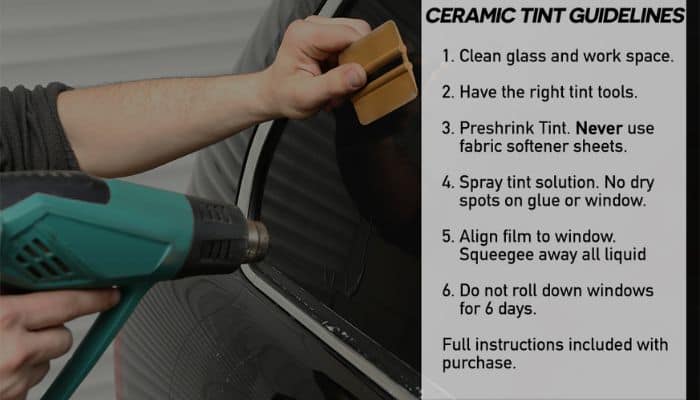
What are the different types of tint films?
All window tint films cut down on the amount of light that can be seen coming into a car. This helps cut down on glare and gives you more privacy. All of the ones we recommend are said to block up to 98% of UV rays, which helps protect your skin and keeps the inside of your car from fading and getting damaged. Most of them only use layers of dyes to get the results they want. They can make your car look good, but they wear off faster and can turn a purple color over time. Metalized films use tiny metallic particles to reflect more sunlight, which helps keep the inside of the car cooler and makes it less likely to fade. Many drivers no longer like this type, though, because it has been said that the metallic particles can mess up the signals of phones, portable GPS navigators, and other electronics in the car. A carbon window tint, which uses tiny bits of carbon instead of metal, is a better choice for many drivers. This is also good at reflecting heat, but there is no chance that it will mess up electronics. It also has a finish that looks like matte and is more durable than basic dyed films. Ceramic film is the most expensive because it uses nano-sized pieces of ceramic instead of carbon or metal. It keeps more heat and infrared light from getting into the car than carbon films do, and it lasts a long time.
What do the tint numbers mean?
Visible light transmission (VLT) percentages for all window tints range from 5% to 70%. The lower the number, the less light that can be seen gets into the car. For example, a film with a VLT percentage of 70 is a lighter shade that blocks only 30% of the light from the outside and lets 70% of it into the car. On the other hand, a VLT of 5 is very dark, letting in only 5% of the light. This is why it’s often used in limos. (The VLT of most sunglasses is between 15 and 25.) In most states, you can only tint the front side windows between 30% and 50% VLT. On the website tinting-laws.com, you can see what the different VLT percentages look like.
Is it legal to tint my vehicle’s windows?
Each state has its own rules about window tinting, so check this AAA site for your state’s rules before you buy. No state lets you tint your whole windshield, but most states let you tint a 5- or 6-inch strip along the top (or down to the so-called “AS1 line” on the windshield). Different rules apply to the side windows and the back window. Tinted windows could be a reason for the police to pull you over. The driver is pulled over for a minor infraction (like tinted windows, an air freshener hanging from the mirror, or a broken tail light) in the hopes of finding a bigger one. Remember that if you put a tint on top of factory-tinted windows, the total amount of light that gets through will be measured. We’ve seen comments from people whose cars didn’t pass the inspection even though they bought a tint that was legal in their state. This could be why. In addition to the above AAA website, windowtintlaws.us has a good explanation of each state’s laws and some helpful articles about tinting (but be ready to sift through the ads).
Can I install a window tint as well as a shop?
Window tints are usually not hard to put on, but you do need a few tools, a clean place to work, and a lot of patience. A pre-cut kit, which has already been cut to fit your car model, is the easiest to put on. When you use a roll of film, you have to measure the windows and cut the film to fit. Most products are put up by spraying the inside of a window with a soap-and-water solution, placing the film on the window, and smoothing it out with a squeegee. Even though a squeegee comes with many products, it helps to have a good basic installation kit, which you can get for less than $20. We suggest that you read the instructions that many companies put on their websites before you try to install something. On company websites or on YouTube, you can also find a lot of videos that show how to install. Compound curved glass, like rear windows that bend in both directions, can be the hardest for first-timers to work with. Some companies say that you should use a heat gun to shrink the film so that it fits well. There are many good YouTube videos, like this one, that show you how to do this. A good heat gun costs about $30, or $50 if it comes with an installation kit. Other companies say to put it on in horizontal strips, even though this can make seams in the tint that can be seen.
How long do window tints last?
It depends on what kind of movie it is. Gila Film Products says that the UV rays will slowly break down the dyes and pigments in basic dyed window tint film. If they are installed and cared for properly, the company says they should last three to four years before they start to fade. But a lot of things affect this, like where you drive and how much direct sunlight the car gets. Films that reflect more sunlight, like those made with carbon or ceramic particles, usually last five to ten years longer.
